Llangyndeyrn, or Llangendeirne, is a small village that sits in its own parish about seven miles south-east of the county town of Carmarthen, and ten miles north-west of the larger town of Llanelli. The Parish Church is dedicated to St. Cyndeyrnin and within the Church is situated the Parish War Memorial, which commemorates ten local men who fell during the Great War of 1914-1918. Tragically four of these men were killed at Gallipoli on the same day, 8 August 1915, whilst two more were killed there within the next two days. Whilst originally researching this page for the website some years ago, I came across several other local men who fell who are not named on this war memorial, plus another man who fell during the Second World War. The village also contains the remnants of a Norman Motte and Bailey castle, but it perhaps better known for its resistance against the plans to flood the valley in which it lies, in order to create a reservoir for the city of Swansea.
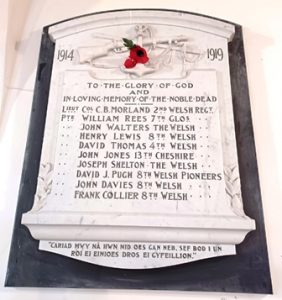
The Great War, 1914-1918
Richard John Anderson, Private, 20534, Welsh Regiment. Richard was born in Southgate, Middlesex in 1891, the son of George Richard Anderson and Elizabeth Anderson (nee Hudson). He was lodging at Glyn Abbey, Llangyndeyrn with his brother William Anderson prior to the war, and worked as aa coal hewer. Richard enlisted at Kidwelly into the 15th Battalion, Welsh Regiment during a recruitment drive by local officers during March 1915. The battalion was known as the Carmarthen Pals battalion and was training at Rhyl, attached to the 43rd (Welsh) Division. The division was then renumbered to the 38th (Welsh) Division, prior to moving to Morn Hill, Winchester, to complete its training. On 2 December 1915 the battalion moved to France, and the entire Division moved to the Fleurbaix sector, where it was initiated into trench warfare alongside the 19th Division. On 1 March 1916 the battalion marched south to take up new positions on the La Bassée canal, a notorious sector known and feared for underground mining by the Germans. On 9 March 1916 the 15th Welsh were in the front line when the Germans blew an underground mine at I Sap, and followed the explosion up with an artillery barrage. Richard was one of seven men killed that day. The 24-year-old was buried in Guards Cemetery, Windy Corner, Cuinchy, France. Richard is not commemorated on the Llangyndeyrn war memorial.
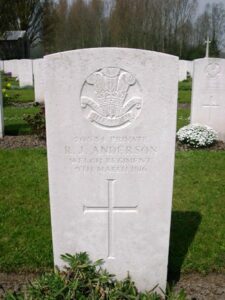
Frank Collier, Private, 955, Welsh Regiment. Frank was born in Burton-on-Trent in 1894, the son of Amos Collier and Sarah Ann Collier (nee Spreckley). Prior to the outbreak of war he had resided in Abergwili, then moved to Llangyndeyrn, where he worked as a servant at the Vicarage. Frank had enlisted at Carmarthen into the 4th Battalion, Welsh Regiment in 1908. The battalion was the local Territorial unit and mobilised for war at Carmarthen in August 1914, as part of South Wales Brigade, Welsh Division and moved to Tunbridge Wells until the end of the month, before moving to Scotland to man the Forth and Tay Defences. On 17 April 1915 the battalion moved to Bedford, joining 158 Brigade, 53rd (Welsh) Division. On 19 July 1915 the entire Division sailed from Devonport for Imbros and on 9 August 1915 landed at Suvla Bay. The infantry moved off the beaches across the Salt Lake, under shellfire, into the scrub covered Chocolate Hill, but due to a lack of maps and no knowledge of the terrain, many of the units became disorientated, and the situation became chaotic. Frank was killed in action the following day, on 10 August 1915. The 20-year-old has no known grave and is commemorated on the Helles Memorial, Gallipoli. His only brother, Percy, was killed on the Somme in 1916.
David Davies, Private, 12577, Welsh Regiment. David was born in 1894, the son of Daniel Davies and Margaretta Davies, of Peny Bank, Crwbin, Llangyndeyrn. He worked as a colliery labourer prior to enlisting at Carmarthen into the 8th Battalion, Welsh Regiment soon after the outbreak of war. The battalion was formed at Cardiff in August 1914, moving to Salisbury Plain to join 40 Brigade, 13th (Western) Division. The battalion moved to Chiseldon in October then in December moved again to billets in Bournemouth, where it became converted to the Pioneer Battalion to the 13th Division. In February 1915 the division moved to Aldershot to complete its training, then on 15 June 1915 sailed from Avonmouth for Mudros, before being landed ashore at Anzac, Gallipoli on 5 August 1915, to fight alongside the Anzacs in a great diversionary attack. The 8th Welsh, now reverting to its infantry role, marched out from Anzac Cove on the following day and took up reserve positions at the mouth of Chailak Dere. The 13th Division launched a great assault on Chunuk Bair on 7 August and took its objectives, despite heavy losses, so at dawn on 8 August 1915 the 8th Welsh moved forwards, supported by the heavy guns of the ships deployed offshore. As the battalion crossed Apex Ridge, the men were mown down by heavy machine-gun fire and was almost decimated. David was killed here that day, on 8 August 1915. The 21-year-old has no known grave and is commemorated on the Helles Memorial, Gallipoli. David is not commemorated on the Llangyndeyrn war memorial.
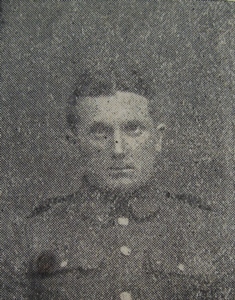
John Davies, Private, 27239, Welsh Regiment. John was the son of John and Ann Davies, of The Bird-in-Hand, Cerney, Broughton, Denbighshire. He became a stone mason prior to moving to Pontantwn, and married Charlotte Stephens at Llangyndeyrn Church on 2 February 1897. The couple initially moved to Brymbo in North Wales, where their first two children were born, before moving back to Pontantwn and set up home at Gwendraeth Villa. John enlisted at Carmarthen into the 8th Battalion, Welsh Regiment in the summer of 1915. The battalion was formed at Cardiff in August 1914, moving to Salisbury Plain to join 40 Brigade, 13th (Western) Division. The battalion moved to Chiseldon in October then in December moved again to billets in Bournemouth, where it became converted to the Pioneer Battalion to the 13th Division. In February 1915 the division moved to Aldershot to complete its training, then on 15 June 1915 sailed from Avonmouth for Mudros, before being landed ashore at Anzac, Gallipoli on 5 August 1915, to fight alongside the Anzacs in a great diversionary attack. The 8th Welsh, now reverting to its infantry role, marched out from Anzac Cove on the following day and took up reserve positions at the mouth of Chailak Dere. The 13th Division launched a great assault on Chunuk Bair on 7 August and took its objectives, despite heavy losses, so at dawn on 8 August 1915 the 8th Welsh moved forwards, supported by the heavy guns of the ships deployed offshore. As the battalion crossed Apex Ridge, the men were mown down by heavy machine-gun fire and was almost decimated. John was killed in action here on 8 August 1915. The 43-year-old has no known grave and is commemorated on the Helles Memorial, Gallipoli.
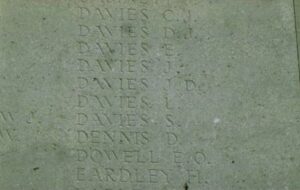
John Jones, Private, 260106, Cheshire Regiment. John was born in 1897, the son of David Jones and Elizabeth Jones (nee Richards), of Tyrsteps, Crwbin, Llangyndeyrn. He worked as a carpenter at Pontyates and then at the Pentremawr Colliery at Pontyberem prior to the war. John enlisted at Carmarthen into the army and was posted to the Monmouthshire Regiment. Upon being drafted to France in June 1917 he was posted to the 13th Battalion, Cheshire Regiment, which was attached to 74 Brigade, 25th Division. The Division been in France since 26 September 1915, and had seen heavy fighting on the Somme the following year. The division had then moved to the Ploegsteert sector, where it had held the line for the months leading up the Battle of Messines in June 1917. John joined the 13th Cheshire’s following heavy losses at Messines that month. On 26 June the battalion had moved to Matringham to refit and remained there for two weeks before moving to Fruges. By the end of July the battalion, now back up to strength, moved back into the battle area and was present when the opening assault of the Third Battle of Ypres, or Passchendaele, was launched on 31 July 1917. The men watched the attack from its positions at Swan Chateau, then on 5 August moved into position to assault Bellewaarde Ridge. John was killed during this assault on 5 August 1917. The 20-year-old has no known grave and is commemorated on the Ypres (Menin Gate) Memorial, Belgium.
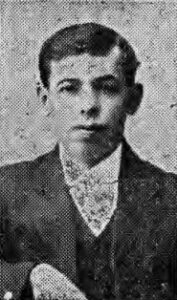
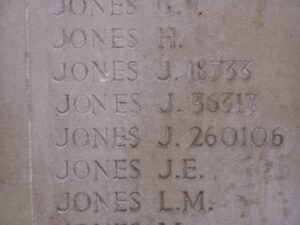
Henry Lewis, Private, 12578, Welsh Regiment. Henry was born in 1886, the son of Richard Lewis and Margaret Lewis (nee Williams), of Tanybont, Crwbin, Llangyndeyrn. He worked as a coal hewer prior to enlisting at Carmarthen into the 8th Battalion, Welsh Regiment soon after the outbreak of war. The battalion was formed at Cardiff in August 1914, moving to Salisbury Plain to join 40 Brigade, 13th (Western) Division. The battalion moved to Chiseldon in October then in December moved again to billets in Bournemouth, where it became converted to the Pioneer Battalion to the 13th Division. In February 1915 the division moved to Aldershot to complete its training, then on 15 June 1915 sailed from Avonmouth for Mudros, before being landed ashore at Anzac, Gallipoli on 5 August 1915, to fight alongside the Anzacs in a great diversionary attack. The 8th Welsh, now reverting to its infantry role, marched out from Anzac Cove on the following day and took up reserve positions at the mouth of Chailak Dere. The 13th Division launched a great assault on Chunuk Bair on 7 August and took its objectives, despite heavy losses, so at dawn on 8 August 1915 the 8th Welsh moved forwards, supported by the heavy guns of the ships deployed offshore. As the battalion crossed Apex Ridge, the men were mown down by heavy machine-gun fire and was almost decimated. Henry was killed in action here on 8 August 1915. The 29-year-old has no known grave so is commemorated on the Helles Memorial, Gallipoli.
Reverend Ivor Morgan Lewis, Chaplain, Royal Navy. Ivor was born at Broughton, near Wrexham, on 20 September 1889, the eldest son of Reverend David Lewis and Caroline Lewis (nee Roberts), of The Grange, Broughton. His grandparents, David and Jane Lewis, lived at Pontantown Farm, Llangyndeyrn, and Ivor and his siblings spent much of their holiday time at the farm. Ivor was educated at St John’s Foundation School, Leatherhead, Surrey, before graduating from Jesus College, Oxford in 1908 with a BA in Theology, becoming a Curate at Uttoxeter in 1912. By now his family was residing at Llysfaen Rectory in Colwyn Bay. Ivor had served in the University OTC during his time there, and a month after the outbreak of war enlisted into the Royal Navy, and was posted aboard the battleship HMS Goliath as the ships Chaplain. Goliath had been stationed in Pembroke Dock at the outbreak of war and was mobilised into the 8th Battle Squadron, serving as a guard ship in Loch Ewe. She then escorted ships carrying the BEF to France before being despatched to German East Africa. From March 1915 she joined the Naval force which had been sent to the Dardanelles and remained in support of the landings at Gallipoli in April. On 13 May 1915 Goliath was situated off Cape Helles when she was struck by two torpedo’s which had been fired by the Turkish ship Muâvenet-i Millîye and sank with the loss of 570 of her crew of 750. Ivor, who was 26 years old, was among the dead. He has no known grave and is commemorated on the Chatham Naval Memorial, Kent. He does not appear to be commemorated locally. His brother, John Gordon Lewis, also fell. The brothers are not commemorated on the Llangyndeyrn war memorial.
John Lewis, Stoker 2nd Class, K/50891, Royal Navy. John was born at Llandyssul on 1 October 1887, the son of Thomas Lewis and Martha Lewis. The family moved to Tynewydd, Llangyndeyrn prior to the war, and John found work as a coal miner at Capel Evan, Pontyberem. John enlisted into the Royal Navy on 3 May 1918, and was posted to HMS Vivid, the Shore Establishment in Plymouth. He suddenly became ill soon afterwards, and died of meningitis in Plymouth on 21 May 1918, aged just 21. John is buried in Ford Park Cemetery, Plymouth. Many thanks to the Cemetery Authorities for supplying the photograph below. John is not commemorated on the Llangyndeyrn war memorial.

John Gordon Lewis, Private, 323332, London Regiment. John was born on 31 January 1891, the son of Reverend David Lewis and Caroline Lewis (nee Roberts), of The Grange, Broughton. His grandparents, David and Jane Lewis, lived at Pontantown Farm, Llangyndeyrn, and John and his siblings spent much of their holiday time at the farm. In October 1908 John begun working for the National Provincial Bank of England as an apprentice at its Stoke-on-Trent branch. He transferred to Rugeley as a clerk in January 1912; before moving to Worcester in January 1913; and then to Oxford in February 1915. John enlisted at Oxford into The Queen’s (Royal West Surrey Regiment), and was posted to the 6th Battalion (City of London Rifles), London Regiment in France. He was killed in action at the Battle of Messines, on 7 June 1917, aged 26. John has no known grave and is commemorated on the Ypres (Menin Gate) Memorial, Belgium. His brother Ivor also fell. The brothers are not commemorated on the Llangyndeyrn war memorial.
William Lewis, Able Seaman, J/42916, Royal Navy. William was born on 8 August 1896, the son of John Lewis and Margaret Lewis, of Panthowell, Mynyddygarreg. He enlisted into the Royal Navy on 18 August 1915 and after completing his training at HMS Vivid I, was posted aboard the destroyer HMS Magic, which was part of the Eleventh Destroyer Flotilla. William married Catherine Elizabeth Anthony of Nantgaredig House, Four Roads whilst on leave early in 1916 and Catherine later gave birth to their only child, a son, William Anthony Lewis. HMS Magic served at the Battle of Jutland on 31 May 1916, but luckily survived the great battle. On 10 April 1918 Magic was on patrol off Northern Ireland when she struck a German mine which exploded and blew off her bow. William was among 25 men killed in the explosion that day. The 21-year-old has no known grave and is commemorated on the Plymouth Naval Memorial, Devon. William is not commemorated on the Llangyndeyrn war memorial, although his parents are buried in the graveyard of the church.
Charles Bernard Morland, Lieutenant-Colonel, Welsh Regiment. Charles was born at Montreal on 12 November 1866, the son of Thomas Morland and Hannah Eliza Morland (nee Servante). He had moved to England before 1871 and had been raised by his grandparents prior to joining the army as a young man and was commissioned into the Welsh Regiment. Charles married Elma Alice Maud Abadam, of Court Henry, a descendant of the Duke of Burgundy, in 1894, and the couple had residences at Cilcennin and Llangyndeyrn. He was a long serving officer and had served with the Welsh Regiment throughout the Boer War. At the outbreak of the Great War he was given command of the 2nd Battalion, Welsh Regiment. The battalion entrained for the south coast within days of war breaking out and on 13 August 1914 landed in France. The battalion was attached to 3 Brigade, 1st Division and entrained for the Belgian frontier, near the town of Mons. The Division then took part in the Battle of Mons on 23 August, following the German invasion of the low countries, and in the epic withdrawal from Mons to the River Marne, where the German drive on Paris was halted. The Germans then withdrew north and took up defensive positions north of the River Aisne, along the Chemin des Dames Ridge and the BEF advanced before launching a frontal attack upon the German positions. The 2nd Welsh suffered terrible casualties here, during heavy fighting around Chivy Ridge and gained its first VC of the war when William Fuller, of Laugharne, rescued the mortally wounded Mark Haggard, under heavy fire. The BEF then began moving to Flanders on 14 October, before advancing from Poperinghe past endless numbers of refugees and took up positions guarding the strategically vital city of Ypres, the 1st Division taking up positions near Langemarck by 21 October. Later that day the division was attacked by hordes of Germans, mainly young student-soldiers, who were mown down by the highly trained British soldiers. The Germans maintained their attacks over the coming days but were held at bay, sustaining terrible losses, and the line here stabilised, so by 27 October the 1st Division moved to positions near Zandvoorde, guarding the Menin Road. On 31 October 1914 the 1st Division faced its sternest test so far, when the Germans attacked its positions on the Menin Road, behind a fearsome artillery bombardment. Charles was killed that day when the battalion was fighting a desperate action at Gheluveldt, when a shell crashed into Hooge Chateau, where the Staff of the 1st and 2nd Divisions were stationed, killing the two Generals in Command. The body of the 47-year-old was taken for burial in Ypres, where he rests today in Ypres Town Cemetery.
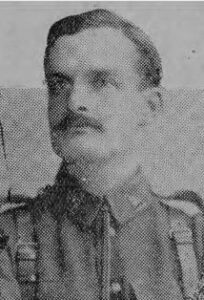
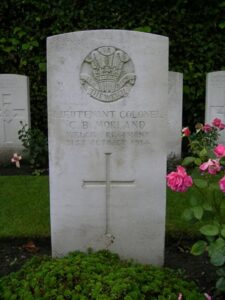
David John Pugh, Private, 11805, Welsh Regiment. David was born at Bolton in about 1881. He had moved to Llangyndeyrn prior to the war and worked as a coalminer. David enlisted at Carmarthen into the 8th Battalion, Welsh Regiment soon after the outbreak of war. The battalion was formed at Cardiff in August 1914, moving to Salisbury Plain to join 40 Brigade, 13th (Western) Division. The battalion moved to Chiseldon in October then in December moved again to billets in Bournemouth, where it became converted to the Pioneer Battalion to the 13th Division. David deserted during January 1915 but was caught in Carmarthen and sent back to the battalion under escort. In February 1915 the division moved to Aldershot to complete its training, then on 15 June 1915 sailed from Avonmouth for Mudros, before being landed ashore at Anzac, Gallipoli on 5 August 1915, to fight alongside the Anzacs in a great diversionary attack. The 8th Welsh, now reverting to its infantry role, marched out from Anzac Cove on the following day and took up reserve positions at the mouth of Chailak Dere. The 13th Division launched a great assault on Chunuk Bair on 7 August and took its objectives, despite heavy losses, so at dawn on 8 August 1915 the 8th Welsh moved forwards, supported by the heavy guns of the ships deployed offshore. As the battalion crossed Apex Ridge, the men were mown down by heavy machine-gun fire and was almost decimated. David was killed in action here on 8 August 1915. The 34-year-old has no known grave and is commemorated on the Helles Memorial, Gallipoli.
William Rees, Private, 12076, Gloucestershire Regiment. William was the son of Thomas Rees and Anne Rees (nee Thomas), of Ystrad Fawr, Llandyfeilog. He worked on his parents farm prior to finding work as a collier in the South Wales Valleys. William enlisted at Pentre into the 7th Battalion, Gloucestershire Regiment soon after the outbreak of war. The battalion was attached to 39 Brigade, 13th (Western) Division. Towards the end of February the entire Division concentrated at Blackdown in Hampshire. On 7 June 1915 orders were received to prepare to move to the Mediterranean and on 13 June 1915 the Division sailed for Alexandria, and moved to Mudros before being landed at Cape Helles, Gallipoli from 6 July 1915, relieving the 29th Division. The Division left and returned to Mudros at the end of the month, before landing at ANZAC Cove from 3 August 1915, to join the great Anzac offensive. William fought on Gallipoli with the Division, but was one of many men evacuated from the Peninsula suffering from dysentery. He was brought by Hospital Ship to the Hospital at Malta, where he died of dysentery on 23 November 1915. The 19-year-old was buried in Pieta Military Cemetery, Malta.
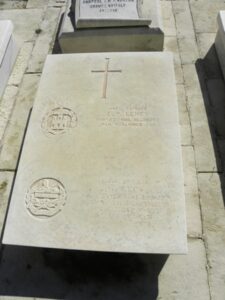
Joseph Shelton, Private, 43056, Welsh Regiment. Joseph was born in Hull in 1898, the son of Joseph Robert Shelton and Caroline Shelton (nee Peacock). Joseph and his brother Arthur were sent away from home as young boys, and by 1911 Joseph was residing at York, where he worked as a cow boy. He then resided at Llangyndeyrn prior to the war. Joseph enlisted at Carmarthen into the Welsh Regiment during the summer of 1915 and upon being drafted to France the following year was posted to the 2nd Battalion, Welsh Regiment. The battalion had moved to France at the outbreak of war, attached to 3 Brigade, 1st Division and had seen terrible fighting during its time at the front. Joseph probably joined the 2nd Welsh on the Somme, where it took part in heavy fighting with the 1st Division during the Battle of Pozieres, seeing terrible fighting around Bazentin Ridge. The 1st Division fought on the Somme for the remainder of the offensive that year, before settling in along the Flers Line for the winter and in between duties in the line, the men were utilised for working parties, in atrocious conditions. The 2nd Welsh began the New Year settled into Becourt Camp, but the men were still kept busy, training and on working parties. On 24 January the battalion was relived and moved back to Baizieux for a rest before returning into the line by 6 February, relieving a French unit at Chuignolles. Joseph was killed during a quiet day in the trenches here on 15 February 1917, when a German shell fragment hit him. The 18-year-old was buried in Assevillers New British Cemetery, France. His brother, Arthur Shelton, had been killed in France in June 1915.
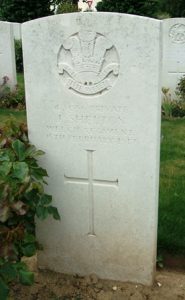
David Thomas, Private, 922, Welsh Regiment. David was the son of Thomas and Hannah Thomas, of 1, Als Hill, Llangyndeyrn. He worked as a coal miner and had enlisted at Carmarthen into the 1/4th Battalion, Welsh Regiment in 1908. The battalion was the local Territorial unit and mobilised for war at Carmarthen in August 1914, as part of South Wales Brigade, Welsh Division and moved to Tunbridge Wells until the end of the month, before moving to Scotland to man the Forth and Tay Defences. On 17 April 1915 the battalion moved to Bedford, joining 158 Brigade, 53rd (Welsh) Division. On 19 July 1915 the entire Division sailed from Devonport for Imbros and on 9 August 1915 landed at Suvla Bay. The infantry moved off the beaches across the Salt Lake, under shellfire, into the scrub covered Chocolate Hill, but due to a lack of maps and no knowledge of the terrain, many of the units became disorientated, and the situation became chaotic. David was killed in action on the following day, on 10 August 1915. The 21-year-old has no known grave and is commemorated on the Helles Memorial, Gallipoli.
John Walters, Private, 201326, Welsh Regiment. John was born in 1895, the son of Thomas Walters and Margaret Walters (nee Davies), of Lan Farm, Llangyndeyrn. He worked on his parents farm prior to enlisting at Carmarthen into the local Territorial Battalion, the 1/4th Battalion, Welsh Regiment. The Battalion was part of 159 Brigade, 53rd (Welsh) Division, moved to the Mediterranean, and had sailed from Devonport in July 1915, and landing on 8 August 1915. John enlisted too late to embark with the battalion for Gallipoli, but was drafted to Egypt early in 1916, following the divisions evacuation from the Gallipoli peninsula. The Division had by now joined the EEF, and helped guard the Suez Canal before taking part in operations to drive the Turks out of the Sinai. The EEF then turned its attention onto driving the Turks out of Palestine, and on 26 March 1917 launched its first offensive against the coastal city of Gaza, which guarded the road to Jerusalem. Initial gains during the day were lost when the assaulting divisions lost touch with each other and communication broke down when a thick fog cloaked the battlefield. John was killed in action here, during the First Battle of Gaza, on 26 March 1917. The 22-year-old has no known grave and is commemorated on the Jerusalem Memorial, Israel.
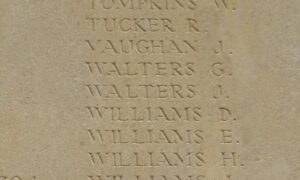
———————————————————————————————————————————-
World War Two, 1939-1945
Arthur James Davies, Private, 3963477, Welch Regiment. Arthur was born on 16 August 1920, the son of Watkyn Davies and Margaret Davies (nee Evans), of Llangyndeyrn. He enlisted into the local Territorial Army battalion, the 4th Battalion, Welch Regiment soon after the outbreak of war. The battalion was attached to 158 Brigade, 53rd (Welsh) Division. The battalion was mobilised at the outbreak of war, when the Division moved to Northern Ireland to begin garrison duties. The Division then moved to Pembroke Dock, before moving again to the south of England, where it trained in readiness for the D-Day Landings. Arthur married Margaret Avril Morris at Porthcawl in 1942. At the end of July 1944 the 53rd (Welsh) Division sailed for Normandy to take part in the break out from the beach-head. Following hard fighting in Normandy the division advanced northwards through France into Belgium and then took part in Operation Market Garden, Montgomery’s audacious drive towards the Rhine crossing at Arnhem through Holland. The operation was ultimately a failure, so the 53rd (Welsh) Division began to take part in operations to clear the Germans from northern Holland. Arthur was killed during the divisions assault on the strongly defended towns of Nuland and S’Hertogenbosch on 24 October 1944. He was 24 years old and is buried in Uden War Cemetery.
Ivor Maurice Jones, Lieutenant, Royal Australian Naval Volunteer Reserve. Ivor was born on 13 May 1907, the son of Arthur and Edith Jones, of Brynglas, Union Street, Carmarthen. He had served with the Royal Navy prior to the war, prior to emigrating to New Zealand, and lived with his wife Gwendoleen Maheno Jones, at Eketahuna, New Zealand. Ivor enlisted into the Royal Australian Navy soon after the outbreak of war and on 15 September 1940 was granted an emergency commission as Sub-Lieutenant. He trained at Brushcutter and Cerburus, then had several postings aboard a number of Australian vessels before being promoted to Lieutenant and posted aboard the County-class heavy cruiser HMAS Australia on 21 March 1944, the day that she rejoined Task Force 74, following a refit. The force then left Australia to support the amphibious landings at Aitape, Humboldt Bay, and Tanahmerah Bay, before providing artillery support for the troops ashore, then began carrying out escort duties. HMAS Australia had a very busy summer, with the war in the Pacific at an intense level. At around 06:00 on 21 October 1944, Japanese aircraft attacked Australia and a number of other ships in Leyte Bay. A Japanese Aichi D3A dive-bomber dove for HMAS Shropshire, but was hit by anti-aircraft fire before diving into HMAS Australia, hitting her bridge and showering the ship with debris and burning fuel. Ivor was one of seven officers, including the Captain, and twenty-three sailors killed by the explosion, whilst another nine officers, fifty-two sailors, and an AIF gunner were wounded. Ivor was 37 years old when he was killed that day, and is commemorated on the Plymouth Naval Memorial, Devon. Ivor is not commemorated on the Llangyndeyrn War Memorial, although his parents later lived in the village and are buried there.